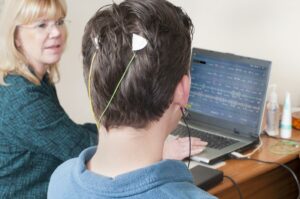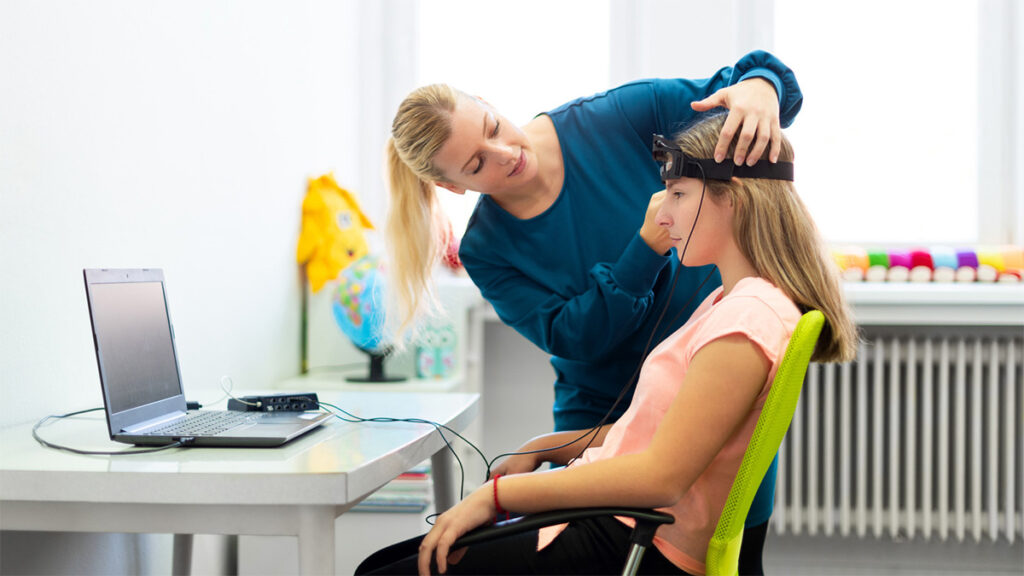TSObsessive-Compulsive Disorder (OCD) is a mental health disorder that can cause extreme anxiety and intrusive thoughts. It affects around 2 percent of the population worldwide, but many people don’t realize how easy it can be to manage the condition through biofeedback therapy. Biofeedback for OCD is a type of psychotherapy that uses electronic sensors to monitor physiological responses in the body. By tracking your body’s signals, you can learn to control your emotions and behaviors better, allowing you to lead a more fulfilling life. In this blog post, we will explore what biofeedback for OCD is and how it can help those with this condition manage their symptoms.
Contents
What is OCD?

Obsessive-compulsive disorder (OCD) is a mental health disorder that affects people of all ages and walks of life. OCD is characterized by obsessive thoughts and compulsive behaviors that can interfere with a person’s ability to function in their daily life.
While everyone has intrusive thoughts from time to time, people with OCD cannot simply “snap out of it.” For people with OCD, these intrusive thoughts are accompanied by intense feelings of anxiety and fear. In an attempt to relieve these feelings, people with OCD engage in compulsive behaviors, which can include anything from excessive hand-washing or cleaning to repetitive checking or hoarding.
Compulsive behaviors may provide temporary relief from the anxiety caused by obsessions, but they ultimately make the problem worse by reinforcing the cycle of obsessions and compulsions. This can lead to a spiraling effect that can take over a person’s life if left untreated.
What is Biofeedback?
Biofeedback is a type of treatment that uses technology to help people learn how to control their body’s response to stress. It can be used to treat conditions like high blood pressure, headaches, anxiety, and chronic pain. Biofeedback for OCD is a newer application of this technology that is showing promise in helping people with this condition manage their symptoms.
OCD can be a very debilitating condition, characterized by intrusive and unwanted thoughts (obsessions) and repetitive behaviors (compulsions) that the person feels they must do to reduce their anxiety. People with OCD often recognize that their thoughts and behaviors are irrational, but they feel powerless to stop them. This can lead to significant distress and interfere with daily life.
Biofeedback for OCD works by helping the person learn to control their body’s physiological response to stress. This is done through the use of sensors that measure things like heart rate, skin conductance, and muscle tension. The person then learns to modify their behavior based on the feedback they receive from the sensors.
One study found that biofeedback was effective in reducing OCD symptoms in nearly 60% of participants. Additionally, those who continued using the skills they learned in biofeedback saw continued improvement over time. This suggests that biofeedback could be a helpful tool for managing OCD symptoms long-term.
How Does Biofeedback Help OCD Sufferers?

The work of biofeedback for OCD sufferers is similar to that of any other patient receiving this type of therapy. By monitoring their bodily functions and providing feedback, patients can identify the physical responses associated with the disorder. This allows them to gain control over their condition by learning how to recognize and manage these responses to reduce symptoms.
As OCD sufferers learn to identify their physical responses and control them, they can reduce the severity of their symptoms. This is done through relaxation techniques such as deep breathing, progressive muscle relaxation, and guided imagery. These techniques help to reduce stress levels, allowing patients to better manage their OCD symptoms.
Biofeedback is particularly effective in treating OCD in children. Research has indicated that when this type of therapy is combined with cognitive-behavioral therapy, children can gain better control over their symptoms and improve overall functioning. It is also important for parents and other family members to become involved in the treatment process, as this can help build a positive home environment where the patient can feel supported and encouraged.
Biofeedback is an effective form of treatment for OCD sufferers, as it helps to identify the physical responses associated with the disorder and teaches them how to control these responses to reduce symptoms. Through relaxation techniques, children can gain better control over their symptoms and improve overall functioning. The involvement of family members in the treatment process is also important, as it can help create a positive home environment that fosters recovery.
Overall, biofeedback is an effective form of therapy for OCD sufferers, allowing them to gain control over their symptoms and improve their overall functioning. Those suffering from this disorder should consult with a mental health professional to determine if this type of therapy is appropriate for their needs. With the right support and treatment, OCD sufferers can gain control over their disorder and lead a more fulfilling life.
Types of Biofeedback For OCD
There are four main types of biofeedback: thermal, electrical, muscle activity, and brainwave. Each type uses different sensors to measure the body’s response to stressors.
Thermal Biofeedback
One of the main forms of biofeedback, thermal biofeedback uses sensors to measure skin temperature. When a person is feeling stressed or anxious, their skin temperature changes due to an increase in blood flow and the release of certain hormones. Measuring this response can help the patient recognize when they are getting stressed and take steps to calm down.
Electrical Biofeedback
Electrical biofeedback uses sensors placed on the skin to measure electrical changes in the body. These changes can indicate increased sympathetic nervous system activity, due to stress or anxiety. By monitoring these electrical signals, biofeedback practitioners can help train patients to recognize and control their response to stressors.
Muscle Activity Biofeedback
Muscle activity biofeedback uses sensors placed on the skin to measure changes in muscle activity. This type of biofeedback is usually used to help people with chronic pain or tension headaches, as it can detect areas of tension in the muscles and allow practitioners to then target those areas with specific exercises.
Brainwave Biofeedback
Brainwave biofeedback uses electrodes placed on the head to measure the electrical signals in different parts of the brain. As a person relaxes, their brainwaves slow down and become more regular. By training patients to recognize when their brainwaves change, they can learn how to control their response to stressors more effectively.
Teaching different kinds of biofeedback is an important part of many treatment plans for patients dealing with stress, chronic pain, and other conditions. As technology advances, biofeedback will become even more accessible and effective as a tool in helping people manage their health.
How Can I Get Started With Biofeedback Therapy?

There are a few different ways to get started with biofeedback therapy. You can either find a therapist who specializes in this type of therapy, or you can purchase a biofeedback device to use at home.
If you decide to see a therapist, they will likely start by asking you about your OCD symptoms and how they impact your life. They will then explain how biofeedback therapy works and what you can expect during treatment. After that, they will help you choose the right type of biofeedback device for your needs.
If you decide to purchase a biofeedback device, there are a few things to keep in mind. Make sure that the device is FDA approved and that it has been tested by an independent third party. Also, be sure to read the instructions carefully before using them.
The success of biofeedback therapy depends on the patient’s commitment to practice and apply the principles they learn in their daily lives. With patience and dedication, biofeedback can be a powerful tool for managing stress, chronic pain, and other conditions.
Are There Any Risks Associated With Biofeedback Therapy?
Yes, there are some risks associated with Biofeedback Therapy. The most common ones include:
Headaches
One of the most common side effects of biofeedback therapy is an increase in headaches. This is usually caused by the tight-fitting electrode sensors placed on the head for brainwave readings.
Headaches can also be caused by long sessions and intense concentration during training. So it’s important to take breaks when needed.
Skin Irritation
The sensors used in biofeedback can cause skin irritation or discomfort due to their close contact with the skin. To minimize this risk, make sure to follow all instructions carefully and wear loose clothing while using a biofeedback device.
Muscle Tension
Biofeedback therapy can sometimes cause muscle tension due to the focus on certain areas of the body during training sessions. It’s important to let the practitioner know if you’re feeling any discomfort during a session.
Dizziness
An increase in dizziness or lightheadedness is another possible side effect of biofeedback therapy. This is usually caused by a rapid change in breathing patterns and should be discussed with your practitioner. This is before you begin treatment.
Anxiety
Some people can experience an increase in anxiety during biofeedback sessions. To reduce this risk, be sure to discuss any concerns or fears with your practitioner before beginning treatment.
Nausea
One of the most common risks of biofeedback therapy is nausea. This can occur during a session, but it usually passes quickly. If you’re feeling nauseous, take a break and let your practitioner know if the symptoms persist.
Biofeedback therapy is generally safe when used with proper care and caution. However, if you experience any unusual or concerning symptoms, be sure to talk to your healthcare provider right away. They will help you decide if this type of treatment is right for you.
Conclusion
In conclusion, biofeedback for OCD is a promising therapy that can help people with the disorder to better manage their symptoms. This method of treatment has been demonstrated to be effective. It is only to reduce distress levels associated with OCD. But also to help individuals develop greater self-control and decision-making skills which can ultimately lead them toward more positive outcomes in life. If you think this type of therapy may be right for you, it’s important to talk to your doctor so they can refer you appropriately.
For more information and guidance, please contact OCDMantra. OCD is a mental health disorder characterized by obsessions and compulsions. If you have any queries regarding OCD treatment, experienced ERP therapy therapists at OCDMantra can help: Book a trial OD therapy session.


